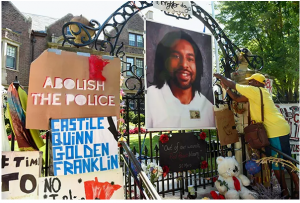The video of George Floyd taking his last breath was difficult for me to process. I experienced anger, sadness, fear, frustration, disgust, outrage, and betrayal. I can’t express what I felt when Floyd begged the officer to remove his knee from his neck and called out to his deceased mother. Watching him being restrained in that moment, I imagined Floyd as a young child—no different from a child I teach—crying out for help.
As a Black male teacher, I ask myself these questions with each new killing of a Black person at the hands of a police officer:
How do I move forward, interact, and answer questions surrounding this killing with white people in my workplace?
How do I explain the injustices in the Black community to my students?
How can I be transparent about the reality of racism without receiving pushback from the school community?
Let’s be clear, I do not seek anyone’s permission or approval to have these questions answered. They can only be answered by me, without apology. The death of George Floyd—and the subsequent protests—have affected the way I need to communicate with white people. I need white people to understand that George Floyd, Philando Castile, Sandra Bland, Jamar Clark, Breonna Taylor, Atatiana Jefferson, Rayshard Brooks, Eric Garner, Michael Brown, Tamir Rice, and so many others died because of the color of their skin.
As we mark the fourth anniversary of Philando Castile’s shooting this month, I think about a question I got from a student that fall.
I vividly recall a 10-year-old white student asking me in class if I were afraid that, as a Black man, I might get shot and killed by a police officer. I was shocked that such a young person would ask me that question but grateful the student trusted me enough to do so. I felt compelled to speak honestly. My student deserved the truth.
Fighting back my emotions, I managed to explain that my worst fear was not dying at the hands of a police officer, but rather having my mother experience the incredible pain that many mothers have over the deaths of their Black sons. In response, students began to ask more questions; I gave them more answers. I was relieved that students appreciated my honesty about a topic that, as one white student offered, no one wants to talk about, not even parents.
The next day, however, my principal told me that a white parent had complained about our classroom discussion. I explained that it was a spontaneous discussion, initiated by a student who asked me a question and that I saw it as an opportunity to not only answer the question but to discuss racism. The principal said the parent’s parting comment was, “I don’t understand why he would be afraid of the police unless he is doing something illegal.” I received the principal’s full support in addressing racism with my students.
It struck me that white people often just don’t get it; they will never understand the experiences of a person of color. Their view of our society is transparently different. For me, this only increases the urgency of having all our students understand the struggle that Black communities face each and every day.
School administrators have the weighty responsibility of creating a school climate free of racial biases for teachers and students. The teachers’ role is to ensure that students and colleagues are demonstrating respect toward all racial groups. I believe the key to building awareness of anti-Black racism is an authentic discussion among administrators, teachers, and staff about their personal experiences with racism. Educating our entire school community about racism in all its forms is vital to the health of our education system.
I believe that all school districts and school employees should be mandated to participate in professional development and training on racial bias and racial inequity. It is imperative to understand how social and systemic racism impact people of color. Understanding the history of civil rights is a prerequisite. A commitment to self-reflection, family involvement, compassion, and empathy toward all racial groups will help educators recognize the role they have played in upholding racism in their own classrooms.
The potential to eradicate social and systemic racism lies with the white people that perpetrate, ignore, participate, teach, and judge Black people. Eradicating this racism is not impossible. I encourage white school administrators and white teachers to pledge that racial discrimination will not be a part of any school’s culture.
To the teachers of America, think about how you incorporate lessons on racism for grades K-12. Why are Black people killed by police officers at a higher rate than any other racial group? Before you ask your students to reflect on that question, make sure you have an answer yourself.
Malcolm J. Gillard is an 18-year veteran teacher who teaches in a Clark County, Nev., elementary school. He is a 2019-20 Teach Plus Policy Fellow.

